How to Use Drum Machines in Songwriting
A Beginner's Guide for Guitar Players
If you want to be a better guitarist, songwriter, and musician it is best to practice with a band.
However, despite our massive population we are more isolated than ever it seems!
But modern technology comes to our rescue with drum machines and virtual drumming software!
In this guide we will get you started using drum machines for your guitar practice and songwriting needs.
Don't Forget To Play Around With The Free Online Drum Machine By FaChords Guitar
The best way to follow this tutorial is to follow it along with the FaChords free online drum machine opened on another page, so you can experiment with real sounds.
Start the FaChords drum machine here.
Rhythm Basics
Before we even use a drum machine app or software, we need to get some foundation in the idea of rhythm.
Rhythms are mostly like chord progressions and bass lines; they are only a handful, and we use them over and over.
Except in occasional circumstances there is no copyrighting a groove unless it is integral to the melody.
Beat/Pulse
Our basic unit when discussing rhythm is the beat or pulse. This pulse can be strong or weak, depending on what kind of accent or flair we use with it.
Syncopation and swing are when we slightly offset the beats to create momentum.
The downbeat is the first beat, and the upbeat is the last.
This anticipation of the upbeat moving back into the downbeat helps give music its drive.
Another way the beat is described is on or off.
In popular music the 1st beat is the strongest with the 3rd a little less, but still strong.
The weak or off-beat is the 2 and the 4. Most popular genres like rock and pop are stressing and syncopating these off-beats.
In fact, most music you will hear today still relies on a backbeat.
Tempo
How fast the beat or pulse moves is called the tempo.
For the most part tempos are not included in the grids below, this is so you will experiment more.
The same drumbeat can be for different genres depending on the speed used.
And sometimes tempo can get confusing with cut time.
Any beat you create or play it is best to try different speeds.
Meter
When we have repeated patterns of beats or pulses that is called the meter.
We will mostly be dealing in duple and triple meters, which are made up of two and three beats respectively.
Try not to confuse it with measures which are phrases or bars that contain a certain number of pulses or beats.
And remember, here we are dealing with drum machines so we may need to break our steps down to fit the right meter!
Rhythm
The rhythm comes from a mix of the different beats, pulses, percussion parts, bass lines, and more.
All these aspects together with different accents and syncopation can create the final rhythm of the song. It is a word that is used in many music situations and part of the definition also has to do with a feel or vibe.
You can play your guitar or another instrument along with your drum machine as a rhythmic accompaniment or if you prefer for a lead melody or solo.
The important part is to understand the difference.
Groove
Like rhythm, groove is not easy to give a specific definition.
It is the cyclical feeling that we derive from a very good and repetitive rhythm.
It can also be called "playing in the pocket."
Groove is not easy on a drum machine;
it is important to get to know the hardware or software you are using so you can take basic patterns and turn them into a groove.
Modern virtual drumming software has an easier time with swing and syncopation as they are more akin to recorded drums sliced up.
Polyrhythms
When you mix different rhythms or meters together that may not normally match, you get a polyrhythm.
And while they can be complicated they are also incredible when all the parts are pulled off correctly.
Some synthesists connect their drum machines together to attempt this and the results can be cool.
Time Signatures
This is how we notate our meters.
Most modern styles use 4/4 or common time and that will be your best chance at a popular tune.
However we will show you some ways to do different time signatures for new song ideas.
The better drum machine you have the more choices, but if you are creative some great time signatures can be made.
Drum Notation
If you ever have trouble finding a rhythm pattern simply look up a songs sheet music and see what notation it has.
Just like reading music you compare the drum notes to the key. It can be tedious but learning to read sheet music is always helpful.
When you can't find song, just look up the genre, and it is likely similar.
And if all else fails in finding a drum pattern, use your ears.
The tried and true method of learning any instrument is listening. Start paying close attention to the drums and rhythms in every song you listen to.
Using Your Drum Machine
Before starting, you might need some instructions.
The FaChords drum machine has been designed to be easy and fun to use, anyway it's better to learn how it works.
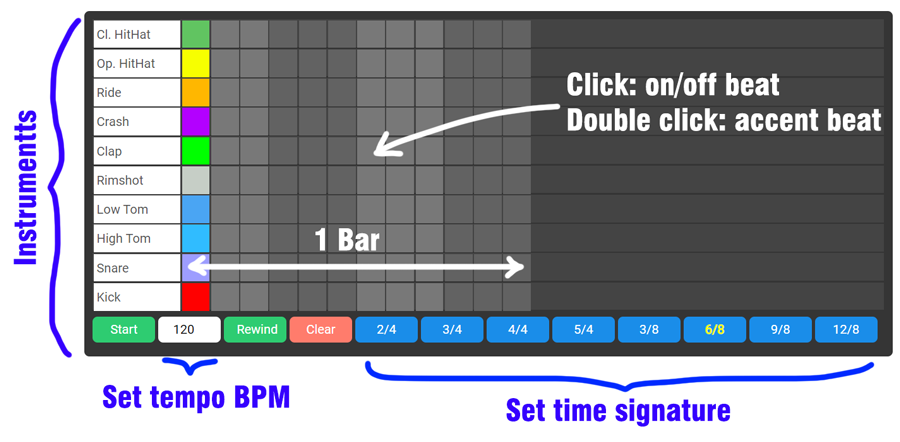
You can switch beats on and off by clicking on the grid; if you use a double-click, you'll get an accented note.
The color codes are not important to memorize as they will still be labeled below.
- Bass Drum
- Snare Drum
- Closed Hi-Hat
- Open Hi-Hat
- Ride Cymbal
- Crash Cymbal
- Lo Tom
- Hi Tom
- Clap
- Rimshot
An A within the chart means that part is accented or stressed
Rhythm Patterns
We will start with some basic pattern templates and move into some more complicated rhythms.
But it is recommended to experiment as you go, after all the whole point of this is to teach creativity in your guitar practice and songwriting.
Our rhythms can be used across a variety of genres.
So if a particular pattern below is given a name attributed to rock or hip-hop it doesn't imply they are stuck in that genre.
It is just an attempt at providing a well-known example.
4/4 Rock-n-roll Pattern

We will start with basic 4/4 rock-n-roll pattern that is a backbone of so much popular music.
We will count the beats in 1/8 notes which will give us two measures in each round.
If you have more than 16 steps just repeat this same pattern
This is the essential rock groove that has been used a trillion times over!
Ok maybe not that much, but it is a staple.
And despite the simplicity there are a variety of ways to this beat. Remember the 2 and 4 are the offbeats and what provide syncopation.
If we accent them and strike them harder it gives us even more emphasis and a rockin' vibe.
Often drummers aren't just hitting a closed hi-hat but using their foot to open it some.
We will take the "and: after the offbeat and use an open hi-hat in place of those. Play the beat below and notice the change in the feel.
The beat has a steady consistency.
4/4 Rock-n-roll Pattern v2
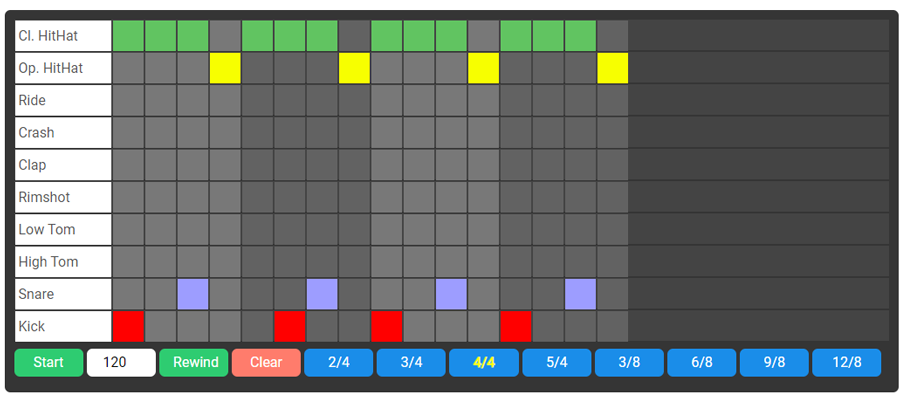
Now remove the last open hi-hat yellow block.
Do not add anything to replace, notice how it now has a halting feeling at the end of each two measures.
Even the tiniest changes provide major sound alterations.
They will require a different lyrical approach that is for sure.
4/4 Rock-n-roll Pattern v3
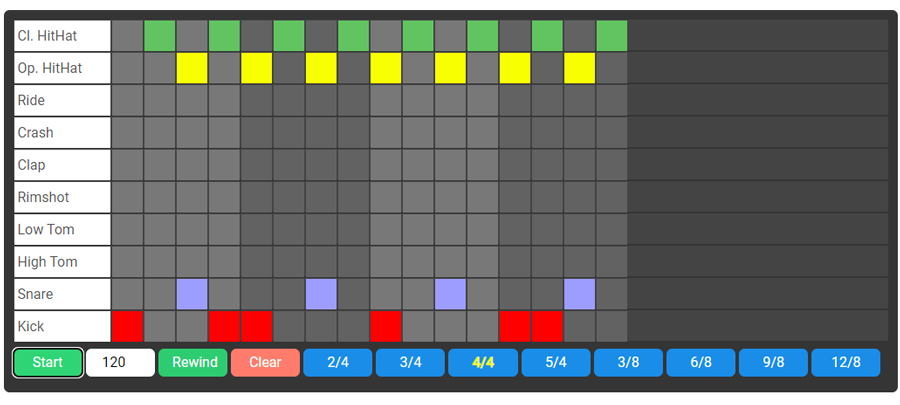
Another way to change the beat is to cut out some of the closed hi-hats like this.
And while we are at it, let's add in a couple more bass beats in there.
Mersey beat
This next one is a very simple mix which was used in the Mersey beat sound similar to The Beatles!
The original beat had a bit of extra buzz added to the snare hits, so try playing around with the snare sound and delay.
And start adding in some hi-hats of course, similar to the patterns above.
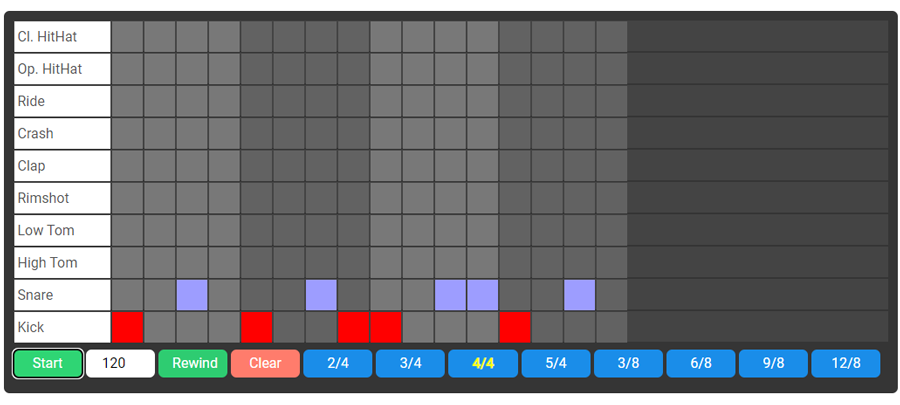
Train beat
Another common beat in rock is the train beat, where we have a constant snare playing.
Now the key to a good train beat is accents on specific snares.
The better your drum machine the more you can play with these constant snare hits and add some variation.
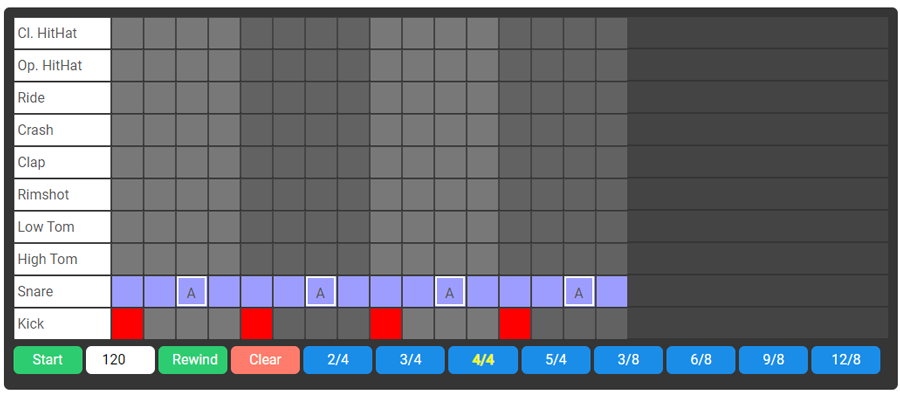
As the real drummer plays they are not smacking the snare with the same force, so by adding different accents you can eventually get that train chugging sound.
If you have more than 16 steps change the accents up a little on the 2ndbar to mix it up.
A country groove
So far we have stuck with the basic four drum kit parts, but a lot of rock and pop music adds toms, cymbal crashes, and claps in.
Granted having more than 16 steps allows for less repetitive tom and cymbal playing.
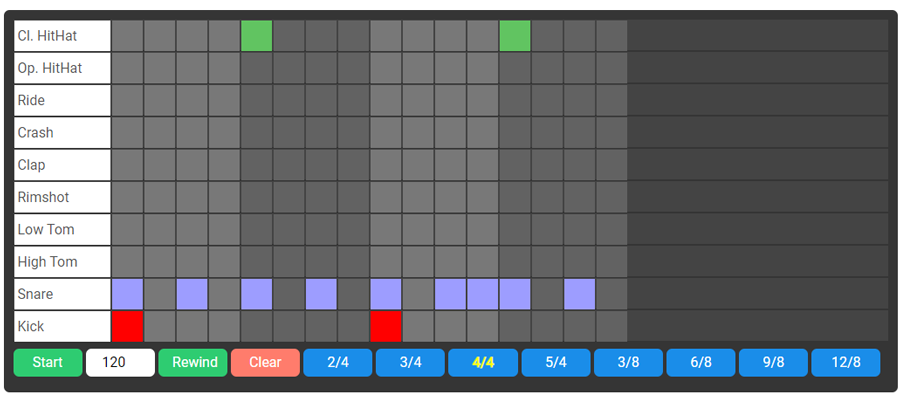
Indie Disco and EDM
Just these simple additions of extra percussive elements can bring a whole new vibe.
If you add open hi hats to each + beat it will give it an even more driving feel.
This rhythm could fit indie disco, EDM, pop, 80's synthwave, and more especially if you play with accents on the beats.
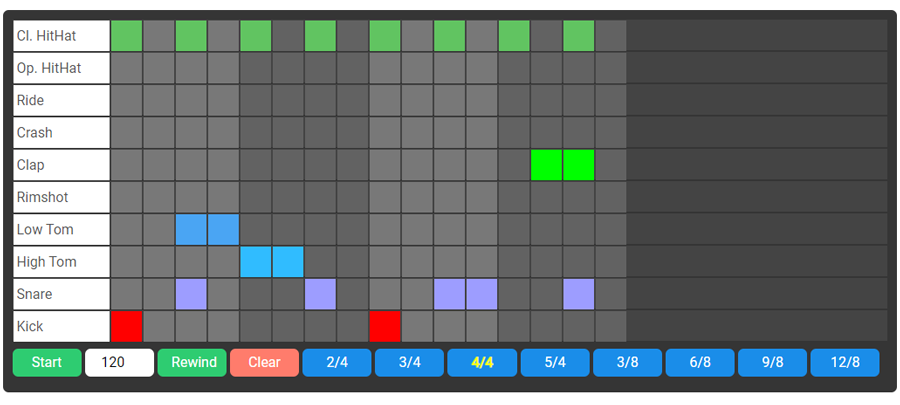
Reggae
Reggae is going to be a challenge on a drum machine, but it can be done.
The key is put the emphasis on the on the 3rd downbeat, and of course to add a lot of syncopation.
We can find ways to mix some swing in by adding in more percussive elements.
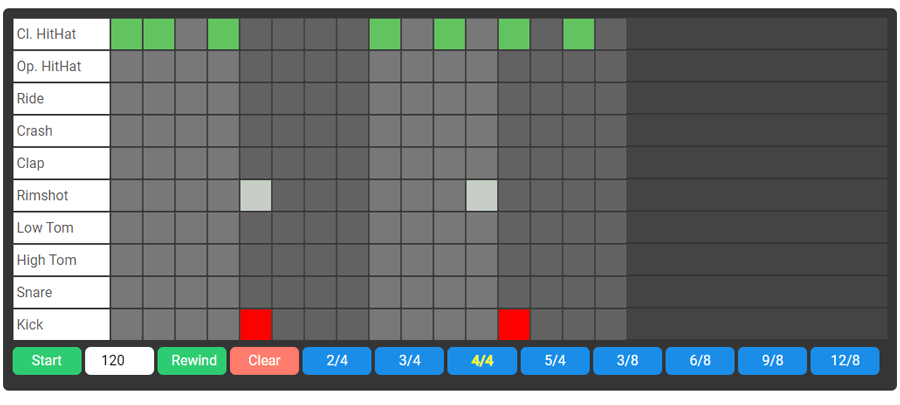
If you do not have a rimshot you can substitute snare and other loud hits.
The key is to keep a groove going with the hi-hats while making sure to hit that 3rd downbeat.
Sometimes the 1st downbeat bass drum is played, other times not.
Try adding the 1 step above in the bass drum and see the difference.
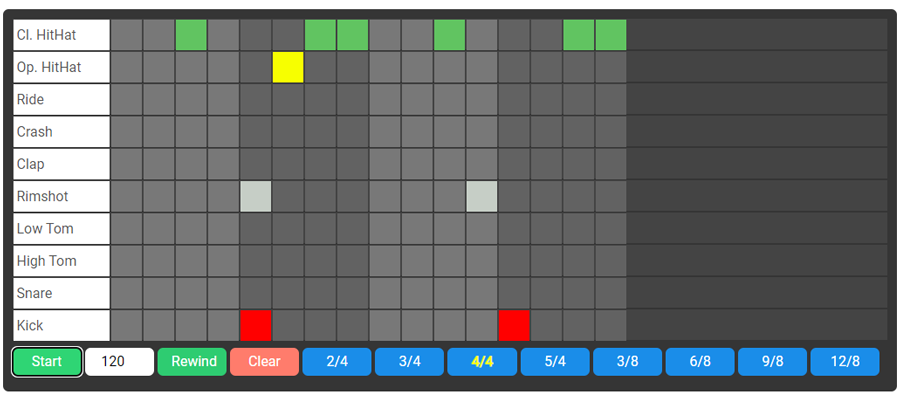
Adding delay to just the bass drum, rimshot, and hi-hat will give you a very groovy reggae vibe.
Add in other parts for more variety.
Funky Drummer
Of course this drum break is one of the most sampled ever from James Brown and Clyde Stubblefield.
If you want to have a chance at a hit song just play around with this pattern and you will likely happen on something the audience loves!
And below are some other famous rap and dance rhythm patterns.
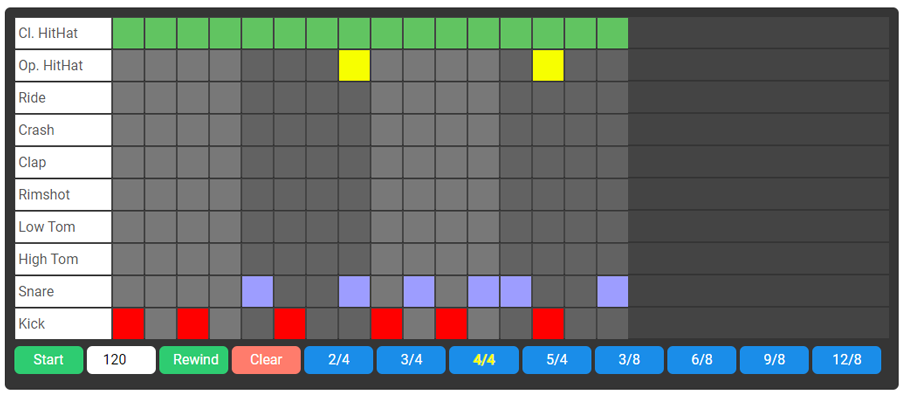
Impeached
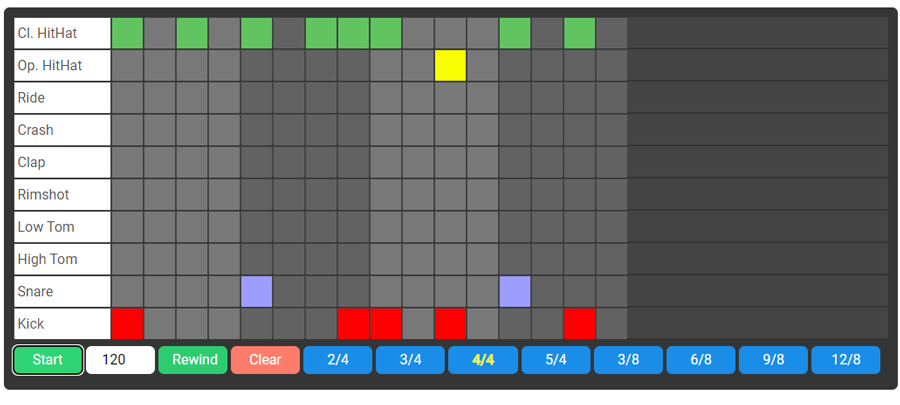
Walk This Way
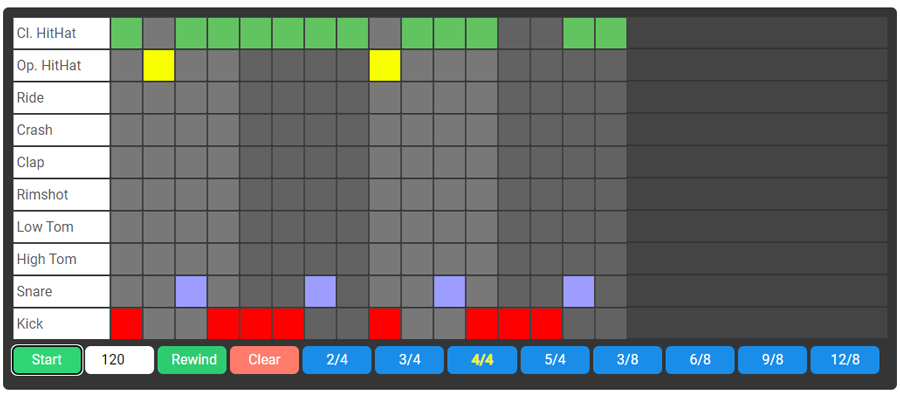
Upbeat Gospel
Gospel is another genre that uses syncopation and 1/16th notes, so if your drum machine isn't too complex you will have to play with the beats to get the right feel.
Of course notice how at a slow BPM it has the R&B vibe but faster it quickly becomes more like dance.
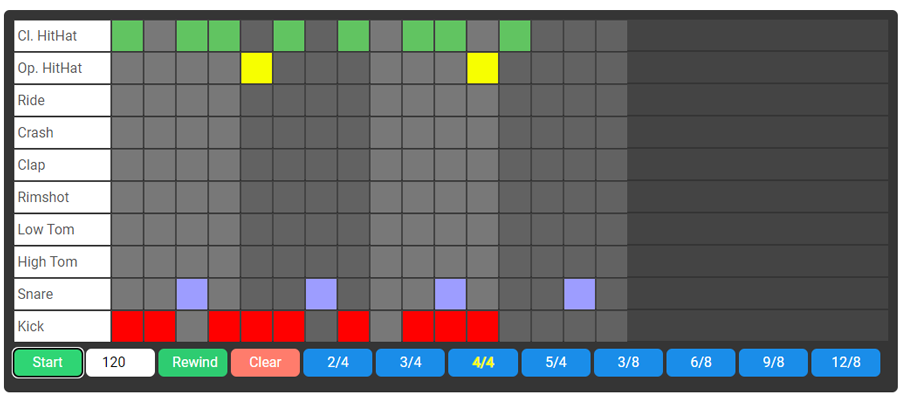
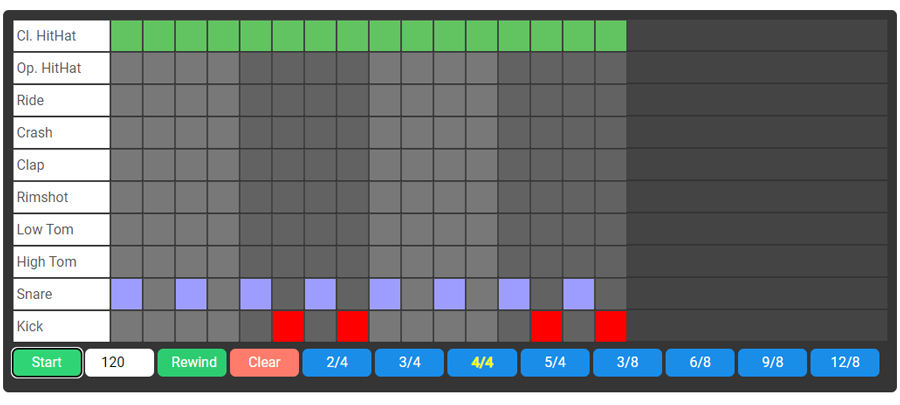
Motown Boogaloo
Motown mixes up where they hit the snare and bass to give it a unique feel, despite the same elements.
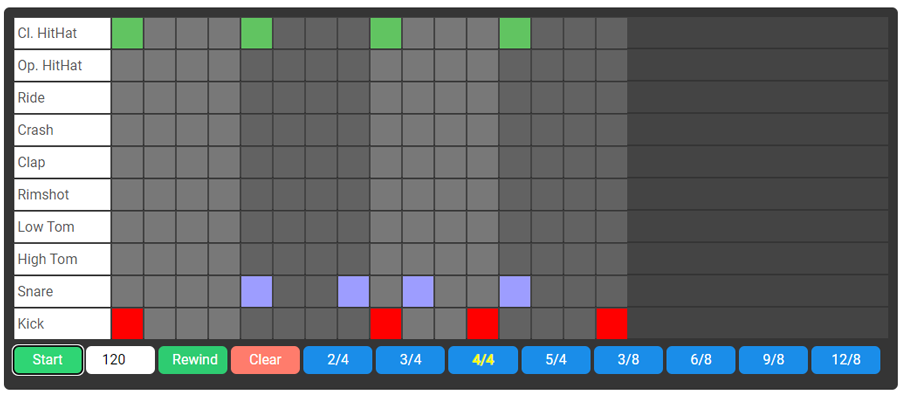
Neo-Soul
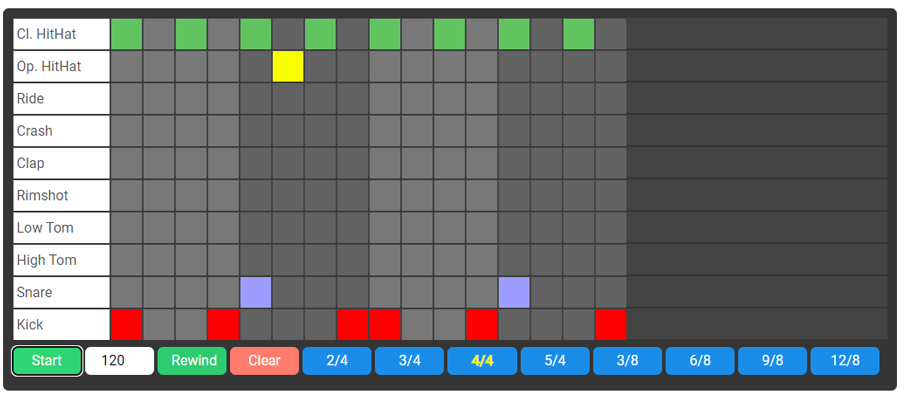
All the time signatures here so far are in 4/4, so we need to change our steps up to change our meter.
You will have to consult the drum app or hardware instructions to know how to turn off certain steps.
Exploring Drum Machines Types
Most drum machines have 16 steps and depending on how they are used will allow you to create different time signatures of varying measures.
We can slice it up in 1/8 notes for rock or 1/16th notes for funk!
If you have more steps, that allows for more variety.
And eventually for potential fills or changes, as a drummer rarely plays the same thing consistently.
As mentioned swing and syncopation are some of the hardest aspects to emulate with a computer. Reggae can be especially hard to get the right groove with a machine.
But as technology improves so does our ability to make realistic drums!
Most apps and hardware either have a swing adjustment or some sort of time and delay change.
Syncopation is simply altering the times of certain notes and beats, so with a little delay we can emulate a groovy swing like feeling.
And accents are an important part of changing simple drumming routines up.
A drummer banging on the toms isn't that impressive, but when you accent specific 1/8 notes like the song "Wipeout", it becomes a pretty awesome rhythm!
Some people still think of drum machines as sterile and robotic grooves played on heavy organs or clunky machines.
In fact, you can find apps that emulate every old drum machine.
If you love Hip Hop there are a thousand virtual emulations of the Roland 808 and 909, a backbone of 80's rap.
The reality is the analog drum machine days have given way to incredible digital and analog hybrid hardware and software.
And once you learn to use these modern drum machines they can and will sound just like real drums.
Whether you want hardware or software make sure it has a lot of sounds and samples to choose from.
Huge Variety of Hardware, Software, Apps
Volca makes a variety of affordable and small synths and drum machines if you wish to go the hardware route.
Apps
Patterning
This is one of the best drum apps around.
It has so many sounds to choose from and allows for fine tuning your accents, which is what gives the beat a human element.
Amplitube
Guitar amp simulators often come with a drum accompaniment which allows you to pick a variety of genres.
This is of course a great way to avoid any programming at all. Simply place the intro, verse, chorus, bridge, and outro in the manner you like.
Funk Drummer / Latin Drummer
This company makes apps that allow you to simply play sections or adjust the MIDI in the grid.
They are worth the cost if you wish to play along with genres that need more realistic swing.
Open Source Drum Machines and Synthesizers
Remember if you want to plug an instrument into your smartphone or computer you will need an interface.
This will allow you to record your guitar and drumming grooves if you like. Otherwise you can simply use the virtual drummer for ideas, practice, and inspiration.
That's all for today. You can subscribe for future updates here, and start the drum machine at this link.
FAQ
Why should guitarists use drum machines for practice and songwriting?
Drum machines help guitarists practice effectively by simulating a 'band' experience, overcoming the isolation of solo practice. They provide a steady rhythmic foundation, which is crucial for improving timing and feel, and serve as a powerful tool for developing and structuring new song ideas.
What is the difference between 'beat,' 'rhythm,' and 'groove' in the context of drum machines?
The 'beat' or 'pulse' is the basic, consistent unit of time, which can be strong or weak. 'Rhythm' is a broader term encompassing the arrangement of sounds over time, formed by a mix of beats, percussion parts, and accents. 'Groove' refers to the compelling, cyclical, and often repetitive feeling derived from a well-executed rhythm, creating a sense of forward momentum or 'playing in the pocket.'
How can I make drum machine patterns sound more natural and less robotic?
To make drum patterns sound more natural, focus on using accents to emphasize certain beats, which adds dynamic variation. Experiment with 'swing' and 'syncopation' settings, if available, as these subtly offset beats to create momentum. Incorporating open and closed hi-hats, and varying instrument choices, also contributes to a more organic feel.
How do 'accents' change a drum pattern on a drum machine, and how do I apply them?
Accents add emphasis and dynamic force to specific notes within a drum pattern, making it sound more expressive and less monotonous. For example, on the FaChords drum machine, you can typically apply an accent by double-clicking a beat on the grid. This technique is crucial for creating varied dynamics, highlighting syncopation, and giving different genres their characteristic feel, such as stressing the 2 and 4 in rock beats.
Can I create different time signatures beyond 4/4 with a drum machine like the one demonstrated?
Yes, while 4/4 is common, drum machines can be used to create patterns in various time signatures. This typically involves adjusting the number of steps or 'beats' per measure within the drum machine's interface. To explore different meters, you would need to understand how to 'break down' your steps to fit the desired time signature and consult your specific drum machine's instructions for adjusting its settings.
Why are reggae rhythms considered challenging to emulate on a drum machine?
Reggae rhythms are challenging because they heavily rely on complex syncopation, an emphasis on the third downbeat (rather than the first), and a specific 'swing' feel that human drummers naturally impart. Achieving this authentic feel on a drum machine often requires careful programming of accents, subtle timing adjustments, and potentially adding delay effects to individual drum parts to emulate the nuanced human timing.